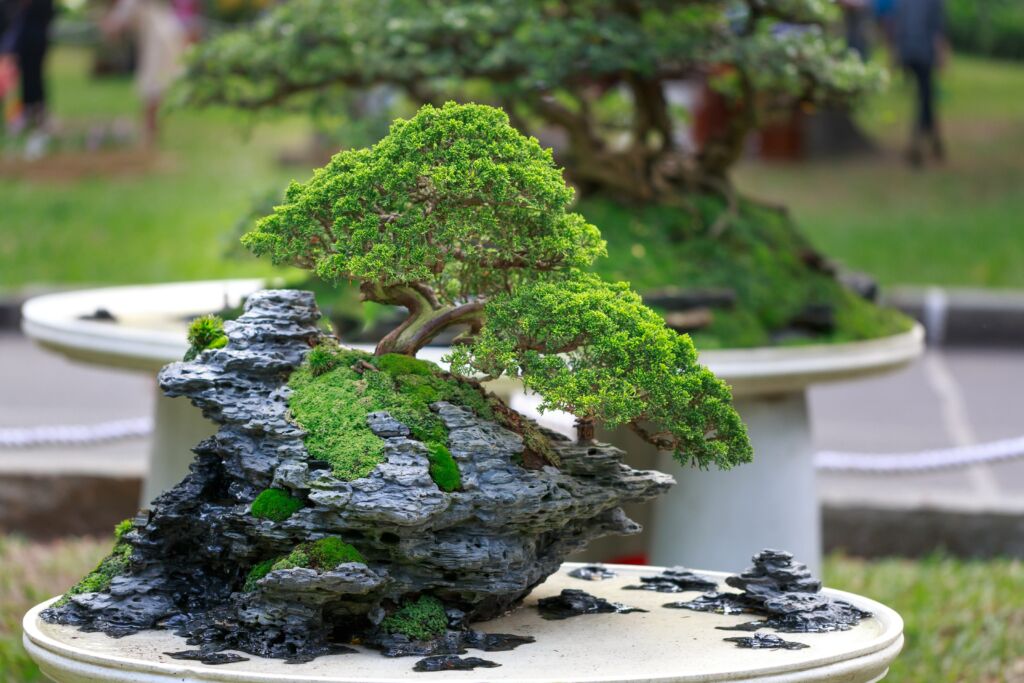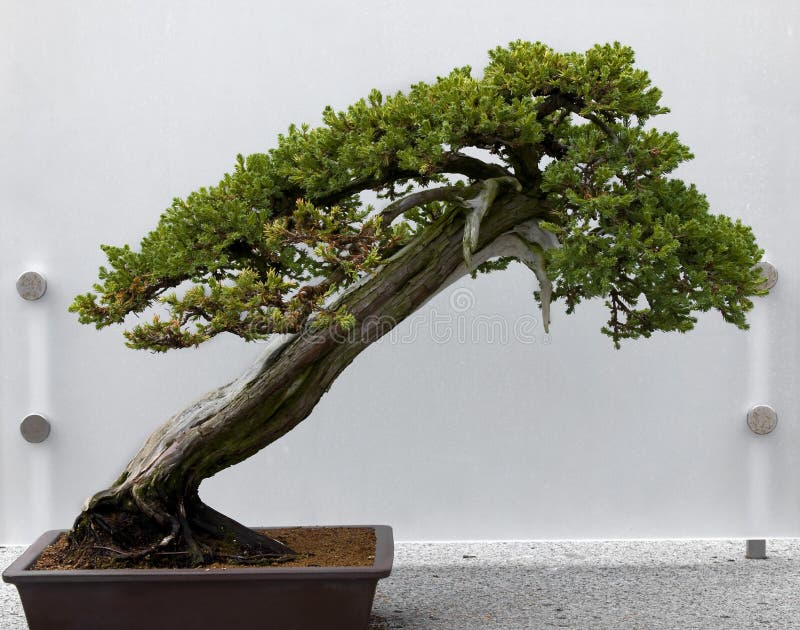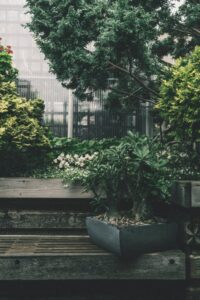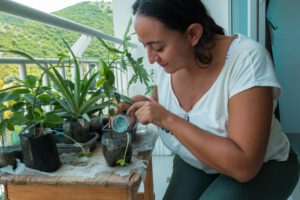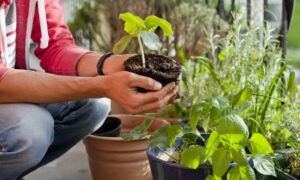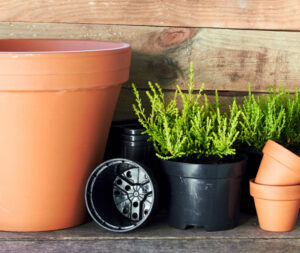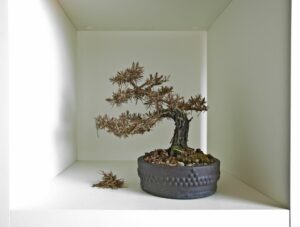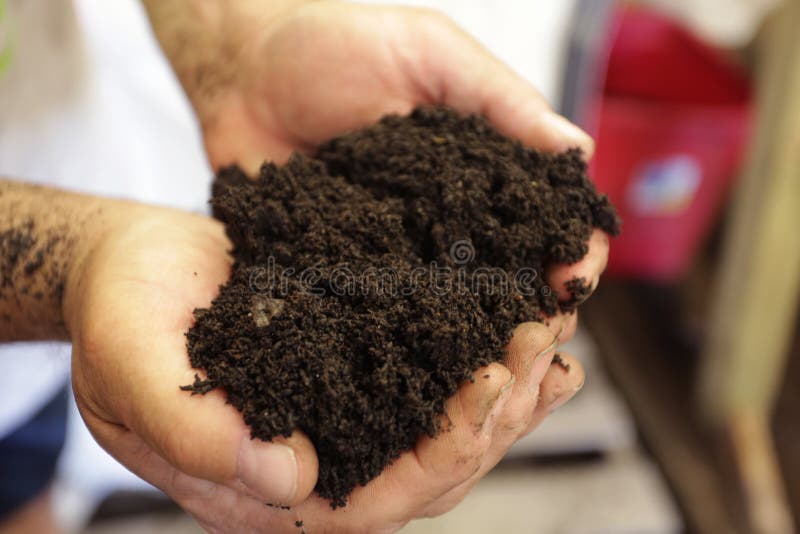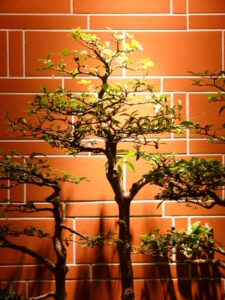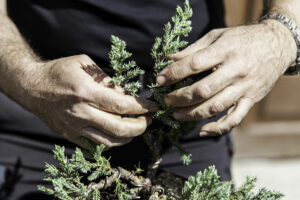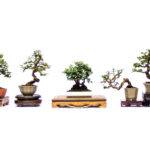HousePlantJoy is supported by our audience. When you purchase through one of our links, we may earn a small affiliate commission. As an Amazon Associate I earn from qualifying purchases. Your cost is not affected.
==================
How Hard is it to Keep a Bonsai Tree Alive?
So, how hard is it to keep a bonsai tree alive? Well, it’s not as difficult as it seems. However, a miniature potted plant like bonsai does require some special care and attention to thrive.
Bonsai trees are known for their reputation as slow-growing, finicky, susceptible to disease, and difficult to manage plants. Putting it nicely, most gardening enthusiasts see them as one of the most challenging plants to care for. So, how to keep a bonsai tree alive and how to maintain bonsai plants?
Regardless of their reputation, it is easy to keep these tiny, handsome trees thriving with the right tools and knowledge.
Below, we will discuss how hard it is to keep a bonsai tree alive ad how to maintain bonsai plants!
What is a Bonsai Tree?
Bonsai is a Japanese word meaning “growing in a container.” Growing miniature trees in containers is a practice that’s been popular in Asia for centuries. “bonsai” doesn’t refer to a specific tree or plant. You can grow any tree and turn it into a bonsai.Moreover, these miniature trees can thrive as long as their counterparts. In Japan, white pine bonsai in Tokyo Palace is over years old. If you are wondering how to keep my bonsai tree alive, you should know that it requires careful and masterful pruning and care techniques to keep thriving.
It takes an amount of patience, discipline, and skills to achieve the ideal form of a bonsai tree. Remember that, unlike any other plant, planting a tree in a pot, watering, fertilizing, and occasional pruning is not enough for a bonsai. It requires your time, patience, and resources.
So, how hard is it to keep a bonsai tree alive?
Guidelines for Caring and Growing a Bonsai Tree to Keep it Alive
Here are some basic guidelines for growing and caring for your bonsai tree:
1. Soil and Orchid Mix for Bonsai Tree
Choosing soil to plant your bonsai tree is a condition that is totally in your control. The type of your chosen soil can also be a significant issue. Although pre-mixed soils are the best, they are usually expensive, and anyone with several small trees could be apprehensive.The soil quality that you choose for your bonsai directly impacts its vigor and health. Unhealthy bonsai trees planted in organic and poor soil lack vigor. Planting these trees in a typical plant garden is also harmful as the soil can quickly get hardened.
Good bonsai soil should have these qualities to keep a bonsai tree alive:
-
Good Water Retention
When choosing soil for your bonsai, make sure it can hold adequate water. It will help supply the required moisture to your bonsai in between watering.
-
Good Drainage
A sound drainage system is also essential, so make sure excessive water should drain quickly and immediately from the pot. If the soil is highly water-retentive but lacks good drainage, it will lead to aeration problems and salt build-up. Moreover, excessive water retention can also cause roots to rot, eventually killing your bonsai plant.
-
Good Aeration
The particles in a given bonsai soil should have enough size and should allow air pockets and tiny gaps between each particle. While oxygen is essential for the healthy formation of roots, having good bacteria and intact mycorrhizae is crucial for food processing.
It will help root absorption and supply nutrients and water to the leaves for producing photosynthesis. Remember that a well-structured, particle-based inorganic soil helps faster water drainage and allows freshwater to enter continuously. On the flip, a compact organic bonsai soil can trigger aeration, structure, and drainage issues, causing root rot.
So, should you use organic or inorganic soil mix to maintain the bonsai plant?
Organic and Inorganic Soils for Bonsai Tree
Bonsai soil mixes can be described as organic and inorganic soil. Dead plants materials, such as leaf litter, bark, or peat, are the primary components of organic soil. These components break down with time, causing water drainage issues.
When watering a bonsai tree in organic soil, the gardener thinks that their tree is getting the required water, but the water actually goes past the soil towards the bottom of the pot.
On the flip, inorganic bonsai soil contains little to no organic matter, such as baked calcite, volcanic lava, or fire clays. While they tend to consume fewer nutrients and water as compared to organic soils, inorganic soils are perfect for drainage and aeration.
Bonsai Soil Components
Bonsai soil mixtures have essential components. It includes:
- Akadama
A hard-backed Japanese clay, akadama is mainly produced for bonsai purposes. It requires to be sifted before you use it. However, keep in mind that after a couple of years, akadama breaks down, causing aeration problems. Moreover, if repotting is not an option, you should mix it with suitable draining soil components to keep a bonsai tree alive.
- Lava Rock
Lava rock is also an excellent component to maintain a bonsai tree. While it offers good water retention, lava rock also offers a good structure. However, bear in mind that it won’t let your bonsai roots grow.
- Fine Gravel or Grit
It is perfect for creating a well-draining and well-aerated bonsai soil. You should use it in the bottom of your bonsai pot for further enhancing water drainage.
2. Watering Bonsai Trees
Watering your bonsai plant is one of the crucial factors to keep a bonsai tree alive. In this regard, you’ll have to consider elements, such as weather, bonsai tree species, and its size. You will also have to monitor the amount of water your tree is getting. Also, make sure that the soil is moist but avoid oversaturating it to prevent root rot and decay.You should bear in mind crucial factors on the frequency of watering the bonsai plants. Below are the correct guidelines that will help to keep a bonsai tree alive and happy.
- Check Soil Moist
It is important to check your bonsai soil to determine if it’s time to water your plant. The factors that affect watering frequency depend on your pot size, tree species, and location. Here is how to monitor soil moisture:
- Whether you are a newbie or a bonsai expert, you can use a moist meter to determine the soil moisture. A soil moisture meter will help you measure the soil’s moisture from root level to prevent over and underwatering.
- Another method to check soil moisture is to use your finger or fingers. However, it can be a bit challenging to gauge moist soil if it is very cold.
- The third method to check soil moisture is the chopstick method. You can use a plain, unstained wooden stick or tongue depressor to check the soil moisture. You can check the moisture of all your bonsais at once by inserting different sticks into the soil.
So, how to keep your bonsai alive and happy by watering it correctly?
1. Watering your Bonsai by Rainfall
Watering by rainfall is a perfect way to keep bonsai trees alive and happy. In this way, you can let the water soak the soil for 20 minutes. You can then further soak the soil again until water starts running from the drain holes.
- Use a Water Hose or a Watering Cane
Make sure to avoid using an overly concentrated pressure of water that can wash out the soil. It is best to use a water can fitted with a fine rose for a small bonsai variety. Moreover, you can also use a low-pressure water hose or mist setting.
- Watering by Immersion
Another way to water your bonsai tree is by dunking or immersion. However, you should avoid frequent dunking as it can harm the roots.
3. Feeding and Fertilizing
Potting your bonsai in a small pot and regularly fertilizing them is essential to prevent deprivation. It will also allow them to consume the essential nutrients they need to thrive. The three most critical macronutrients that bonsai trees need include phosphorus, potassium, and nitrogen.Nitrogen is essential for enhancing the growth of stem and leaves, phosphorus encourages the healthy growth of roots, and potassium boosts the growth of fruits and flowers.
Here is what you will need to feed your bonsai trees:
- Teabags
- Preferred fertilizer
- Measuring cups
- Baskets
Keep these tricks in mind when feeding your bonsai trees:
- Bear in mind that bonsai tree soil mixes don’t contain adequate clay or fines for storing nutrients. So, make sure to fertilize them regularly and abundantly.
- Growing bonsai trees in a sandy loam require less watering and fertilizing. However, setting up a formula can be tricky as many factors are involved. The best way to feed and keep a bonsai tree alive is to determine the supply of good nutrition through the color of leaves, appearance, and growth.
- Remember that your bonsai tree’s root system is more efficient than its leaves as it takes up all the essential nutrients and water. When applying fertilizer to the leaves, the roots will get up and store more nutrients.
4. Repotting
Regularly reporting is essential to keep a bonsai tree alive. Repotting your bonsai tree will make sure to prevent starvation and root or pot bound. The technique also helps maintain the bonsai plant to keep it thriving.Depending on the species and pot size, you can decide when is the right time to repot your tree. For mature bonsai plants, it’s best to report them every three to five years, while fast-growing bonsais should be repotted once a year.
So, what’s the best time to repot your bonsai trees?
Well, the ideal time to repot your bonsai depends on various factors. These include health, age, species, and size of the pot. However, young and active bonsais need more frequent repotting than mature bonsai trees.
The procedure to repot your bonsai is very delicate since the roots can dry out quickly. So, make sure to gather all the material you need ahead of time. Things you will need include:
- A new pot.
- Good working area.
- Suitable bonsai soil.
- Root hook.
- A wire to secure your bonsai tree.
- Pencil or chopsticks.
- Water bottle.
Once you’ve gathered all the material, here are the steps you need to follow:
- Firstly, you should determine the best time to repot your bonsai tree. In order to analyze the presence of rootbound, live the tree cautiously. If you see the roots are encircling the inside and around the pot, it’s time to report.
- Carefully remove the old soil as much as possible from the roots. In this regard, you can use a root hook to knock the soil out of the roots.
- After untangling the roots, prune the longer roots to prevent outgrowing the pot. However, make sure not to remove more than 25% of the root mass. It will help ensure adequate roots are left to absorb nutrients and water.
- Now, you can reposition your bonsai tree in the new pot. After trimming the roots, lower your tree back into the pot and fill it to the brim with potting mix. Also, don’t forget the soil and root structure to make sure no air pockets are left behind in between the roots.
- Water it, so the bonsai compost soil settles once you are done repotting your bonsai tree. Keep your tree protected from strong winds for at least a month.
5. Location and Positioning
Location and positioning are also significant factors that you should take into account. Since every bonsai is different, looking for specific information about placement and positioning is essential to keep a bonsai tree alive.For outdoor bonsai trees, it’s best to position them in a place where they can get plenty of sun during the day and an ample amount of shade. While for indoor bonsai plants, you should put them in a sunny location. Some bonsai species require direct sunlight, while others prefer some shade.
6. Containers and Pots
Choosing a suitable container or pot is also essential to maintaining a bonsai tree. When choosing a container or pot, you have to consider some concerns. Firstly, the container or pot should be large enough to hold your bonsai tree easily. Make sure it allows roots to grow steadily.Moreover, your container should also be small enough for controlling and confining the growth to keep it limited to that pot for more extended periods.
When choosing a bonsai pot, keep these tips in mind:
- Keeping your bonsai tree alive and happy should be your top priority. Mature bonsai trees usually have enough training so they are established and can adapt easily to small pots. Remember that patience, perseverance, and hard work are required to keep a bonsai tree alive and happy. When choosing a bonsai pot for your trees, you have to apply these qualities.
- When choosing a bonsai pot, measurement is critical, especially the depth.
- Make sure that your pot should complement with characteristics of your bonsais, such as fruits, flowers, shapes, and sizes.
- If you have bonsai trees with flowers or fruits, I recommend using glazed-colored pots. You can use gray or brown bonsai pots for evergreen bonsai trees like juniper and pine.
7. Common Bonsai Pests and Diseases
Like any other tree or plant, bonsai trees are also susceptible to pests and diseases. Since most bonsai trees grow outdoors, some species, such as quince, are more prone to weak root systems and damage.Harmful microbes or pathogens can sneak in through these areas, killing your entire bonsai tree. You can prevent your bonsais from pests and diseases by keeping your trees healthy. Here are a few tips for applying careful bonsai management.
- Some bonsai trees, such as Fukien Tea trees, are appealing to insects. Using systemic insecticides, you can keep mealybugs and other common insects from your bonsai trees. Inadequately treating your bonsais can encourage mealybugs to cause major problems. They can weaken your bonsais and eventually kill them.
- The scale can also cause harm to your bonsais. You can detect them when your trees become sticky secretions that turn black. Scales are black or brownish bumps on leaves and twigs.
- Aphids are another small insect commonly seen at the tips of bonsai tree branches accompanied by ants. You can treat them using mild soap and water sprays. Moreover, you can also remove them through a water spray, or Q-tip soaked in rubbing alcohol.
So, that’s how hard it is to keep a bonsai tree alive. Now, let’s talk about growing and maintaining a bonsai plant.
How to Maintain and Keep Bonsai Plants Alive?
So, how to maintain a bonsai plant? Well, at first, it might seem an intimidating task, but with the tips below, you will be able to maintain bonsai plants with ease:
How to Position Your Bonsai?
Correctly positioning your bonsai plant is crucial to keeping a bonsai tree alive. In this regard, the first step is to know what type of tree you want to grow and whether it’s an outdoor or indoor plant. Some common types, such as spruce, pine, and juniper, are outdoor trees and should be revealed to the seasons like their counterparts.
Outdoor bonsai plants also include deciduous plants, which means the leaves will change with the season.
On the flip, indoor bonsai plants are generally subtropical species and prefer stable temperatures. These include Hawaiian umbrella trees, jade plants, and Ficus trees.
The rest is simple once you know what type of bonsai you have. Some general tips that apply to all bonsai plants are:
- Make sure to keep your bonsai trees away from direct heat and draft.
- Keep your tree in an area with ample sunlight.
- Humidity is perfect for all bonsais to keep the soil moist.
Your Bonsai Tree Prefer Direct Sunlight
Bear in mind that at least six hours of direct sunlight is essential to keep a bonsai tree alive and happy. However, there are some varieties that prefer more light or more shade as well. So, it is best to consider the particular care guidelines. You can put your bonsai on a window sill so it can get plenty of sunlight.Prune Your Bonsai from Early Spring to Fall
Pruning during the growing season is also essential to keep a bonsai plant alive and healthy. The ideal time to prune the branches and leaves is early spring to fall. It helps keep the tree compact and encourages new growth. You can use a healing tape on cut areas to keep your bonsai from diseases when you are done pruning.
Use a Wire to Shape your Bonsai
Using copper or aluminum wire, you can maintain the bonsai plant’s shape. When it is dormant in the winter, use the wire to wrap stems, bending them in your desired shape. Once the branches grow in your desired direction, remove the wire carefully to avoid scars.
Repot Your Bonsai Every Few Years
Repotting plays a crucial role in keeping a bonsai alive and healthy. When repotting your bonsai, use a new pot that should be at least a couple of inches wider, provide the plant with fresh soil, and prune the root ball. The frequency of repotting a bonsai depends on your bonsai species.Wrapping It Up
So, how hard is it to keep a bonsai tree alive? We have discussed everything related to bonsai care in great detail. Using our tips, you can keep a bonsai plant alive forever. Remember that you have to be patient to maintain bonsai plants as they are slow-grower and require masterful skills to keep growing.
Read More:
https://houseplantjoy-temp.siterubix.com/indoor-bonsai-tree-care-the-hobby-that-grows/

